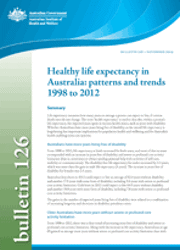Summary
Life expectancy measures how many years on average a person can expect to live, if current death rates do not change. The term 'health expectancy' is used to describe, within a person's life expectancy, the expected years spent in various health states, such as years with disability. Whether Australians have more years living free of disability as the overall life expectancy is lengthening has important implications for population health and wellbeing and for Australia's health and long-term care systems.
Australians have more years living free of disability
From 1998 to 2012, life expectancy at birth increased for both sexes, and most of this increase corresponded with an increase in years free of disability and severe or profound core activity limitation (that is, sometimes or always needing personal help with activities of self-care, mobility or communication). The disability-free life expectancy for males increased by 4.4 years, which was more than the gain in male life expectancy (4 years). The increase in years free of disability for females was 2.4 years.
Australian boys born in 2012 could expect to live an average of 62.4 years without disability and another 17.5 years with some form of disability, including 5.6 years with severe or profound core activity limitation. Girls born in 2012 could expect to live 64.5 years without disability and another 19.8 years with some form of disability, including 7.8 years with severe or profound core activity limitation.
The gains in the number of expected years living free of disability were related to a combination of increasing longevity and decreases in disability prevalence rates.
Older Australians have more years without severe or profound core activity limitation
From 1998 to 2012, there was a clear trend of increasing years free of disability and severe or profound core activity limitation. Along with the increase in life expectancy, Australians at age 65 gained on average more years without severe or profound core activity limitation than with it: males gained 2.3 limitation-free years and 0.7 years with severe or profound core activity limitation; females gained 2.0 limitation-free years and 0.3 years with severe or profound core activity limitation.
Males at age 65 in 2012 could expect to live an average 8.7 years without disability and another 10.4 years with some form of disability, including 3.7 years with severe or profound core activity limitation. Females at age 65 could expect to live 9.5 years without disability and another 12.5 years with some form of disability, including 5.8 years with severe or profound core activity limitation.
The gender gaps are narrowing in life expectancy and years living free of disability
Although women could expect to live longer and live more years both with and without disability than men could, gender gaps in life expectancy and years free of disability and severe or profound core activity limitation are narrowing across all ages.
During 1998-2012, the gender gap in years free of disability at birth was almost halved from 4.1 years to 2.1 years. At age 65, the gap was halved from 1.6 years to 0.8 years. The gap in years without severe or profound core activity limitation at age 65 narrowed from 1.2 years to 0.8 years.
The reduced gender gaps in health expectancies were partly associated with gender differences in the decline of disability prevalence rates.
Introduction
- Methods and data sources
Health expectancies in 2012
- Health expectancies at birth
- Health expectancies at age 65
Trends in health expectancies from 1998 to 2012
- Changes in health expectancies at birth
- Changes in health expectancies at age 65
Age and sex differences in health expectancies in 2012
- Differences in expected years living with disability
- Differences in expected years living free of disability
Change in gender gap in health expectancies 1998 to 2012
Disability prevalence rates 1998 to 2012
- Sex differences in disability prevalence rates in 2012
Is morbidity compressing?
- Proposed health scenarios and related measures of health expectancies
- Recent Australian evidence relating to the proposed health scenarios
Appendixes
Appendix A: Appendix tables
Appendix B: ABS survey definitions of disability
End matter: References; Acknowledgments; Abbreviations



